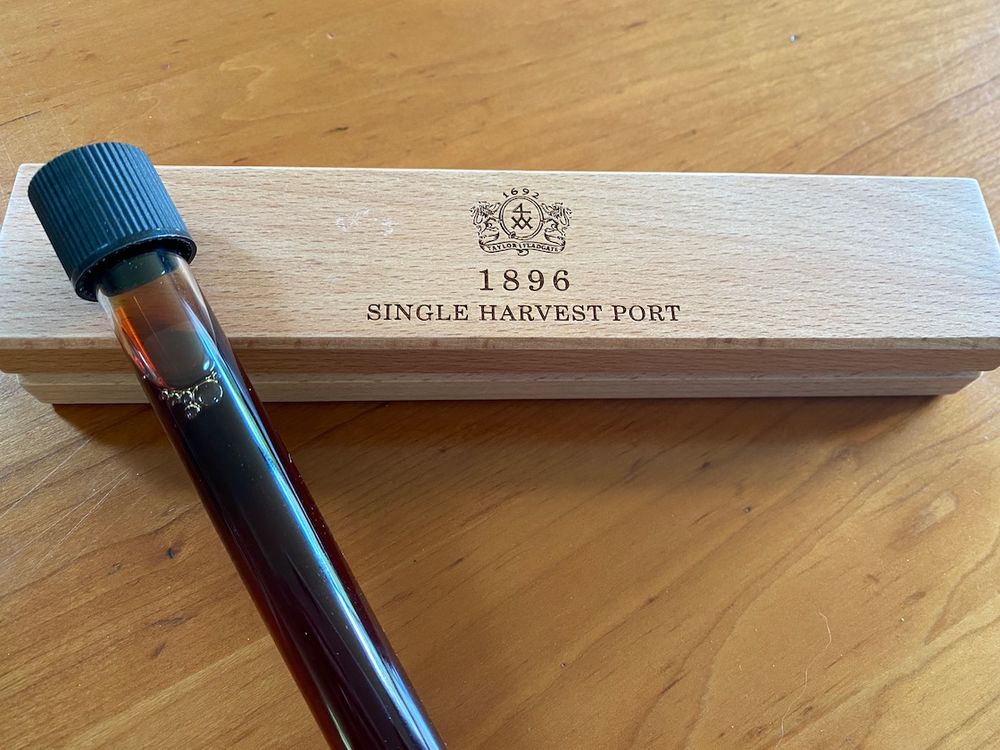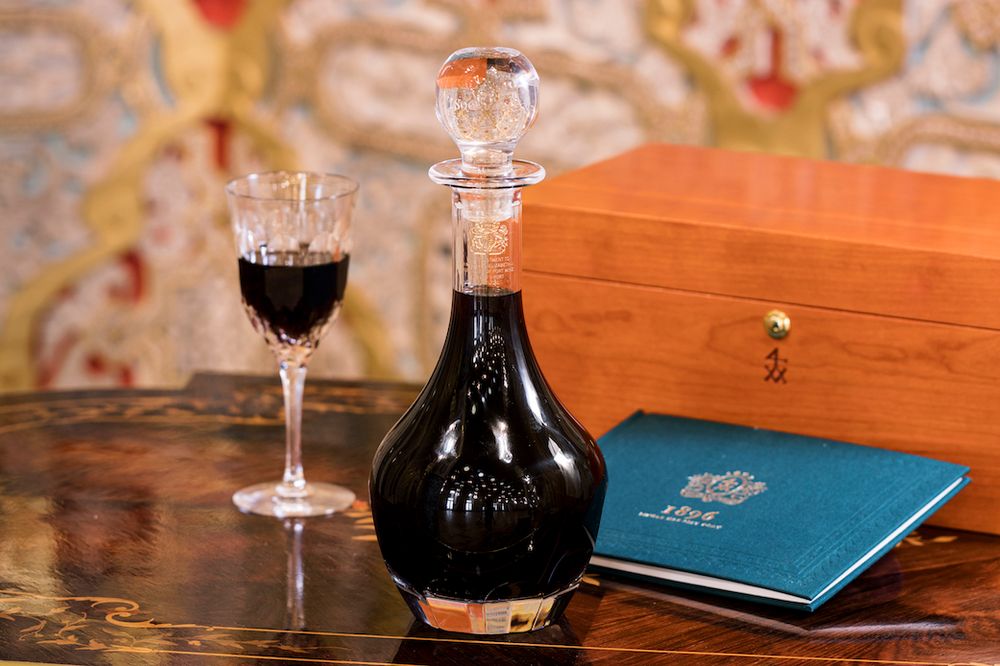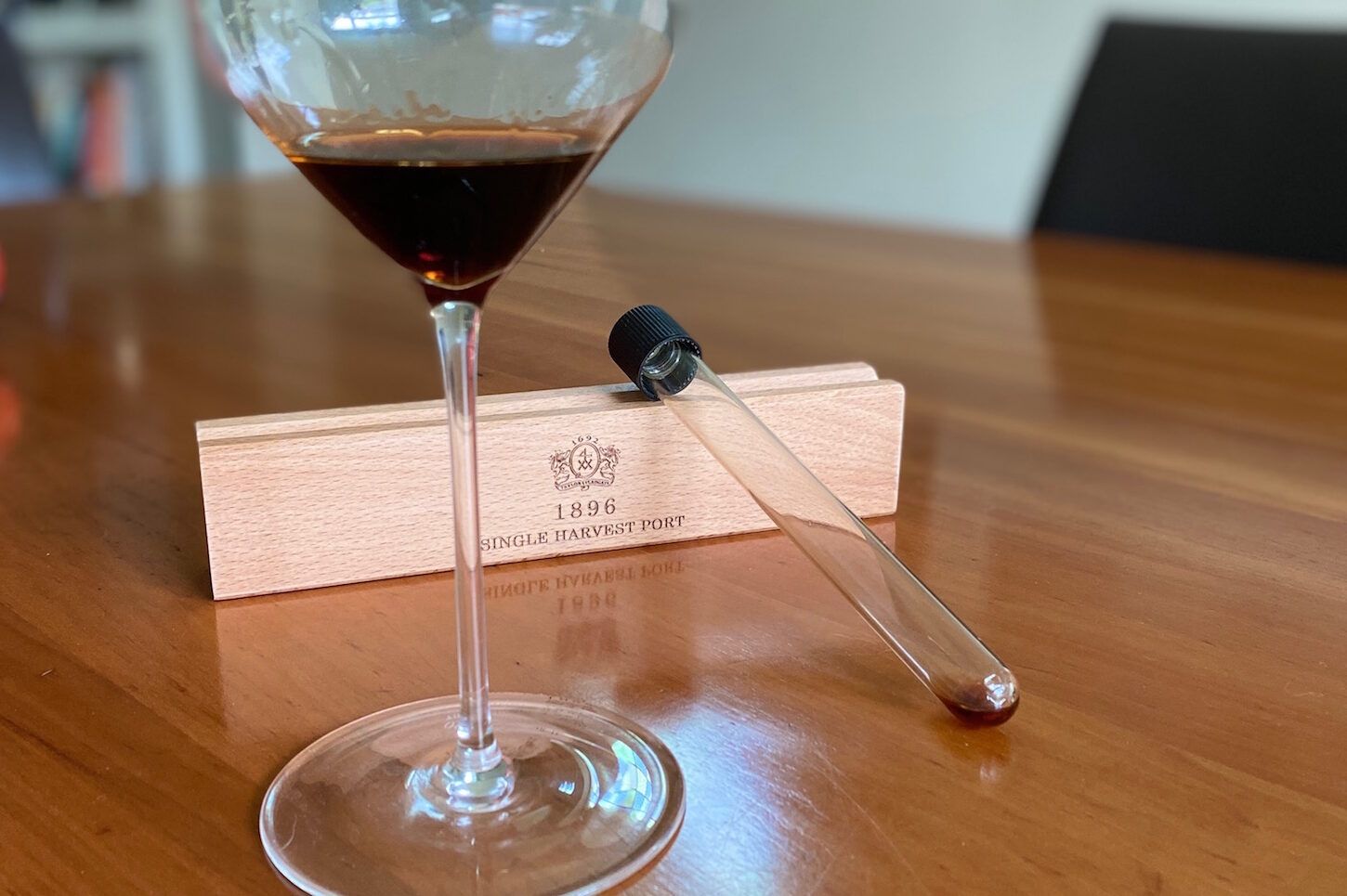“The concentration and power of the Taylor’s 1896 Single Harvest Port makes it effectively an essence,” writes Dean.
It is customary for a wine journalist to reference historical events to put into context the age of a wine or spirit. With wine we are accustomed to reading ‘This wine was bottled when the Beatles had a hit with…” “This was a vintage when Margaret Thatcher came to power” and so on. But when it comes to fortified wines and spirits it is a whole different ball game. The latest very old single harvest port release, Taylor’s 1896 Single Harvest Port has an historical context that is bewilderingly old.

The press sample of the Taylor’s 1896 Single Harvest Port
In the souvenir booklet, included in the collector’s cherrywood box that contains the handblown Scottish crystal decanter of Taylor’s 1896 Single Harvest Port, we read that this was the year when the Dow Jones was started, when La Bohème had its premiere, when radiography was born.
Some lesser known, but no less contextual, events include Walter Arnold of Kent receiving the first ever speeding ticket for driving above the-then speed limit of 2 miles per hour; this was also the year of the first fatality by automobile, the car this time not driven by Mr Walter Arnold. The Daily Mail newspaper was born in 1896 as was Oswald Mosley and the National Trust acquired its first ever property for preservation – Alfriston Clergy House in East Sussex – for the princely sum of £10. In 1896 we also witnessed the world’s shortest ever war – the Anglo-Zanzibar War which started at 9am in the morning and finished 45 minutes later; slightly longer at the crease was the Yorkshire cricket team which posted a single innings total of 887 against Warwickshire, a county championship record that still stands today.

The somewhat larger version that £3,950 will bring you – if you are one of the lucky 1700 ones.
A port of historical significance to Taylor’s
There’s no denying that the Taylor’s 1896 Single Harvest Port is also something of a survivor, having been made from vines that survived phylloxera and which, 125 years after it was made, is still tasting magnificent with genuine vivacity.
The 1700 bottles have come from two pipes of port which is all that is left of an original 18 pipes of port – the rest having evaporated over the years. The evaporation rate is put down as an average of 2% per annum but the rate is higher initially and slows down as the liquid becomes more viscous. As the water and alcohol evaporates so the sugar remains, making the liquid very sweet with 218.00 grams per litre residual sugar but the acidity and volatile acidity that develops over time balances perfectly the concentration and sweetness.
This is not the first time that Taylor’s has released a very old port from its extensive reserves of old cask-aged ports in the cellars at Vila Nova de Gaia – there was the very rare SCION from 1855 and the single harvest 1863, which was one of the last pre-Phylloxera wines to be released – but ‘new’ port releases from the Nineteenth Century are still a very rare occurrence, and made evident by the excitement on the faces of Adrian Bridge and David Guimaraens during the online tasting.

Taylor’s managing director Adrian Bridge and winemaker David Guimaraens (r-l)
“We look at tawny ports once or twice a year – particularly the very old ones – and with each one you get a reflection of the character of that year. A date does define something and when I taste it – I will never forget how such an extraordinary port could have been shaped by time to be then released to this moment,” says Bridge.
1896 was a particularly significant year for Taylor’s because it was the year that it concluded its purchase of Quinta da Vargellas, one of the great vineyards of the world. Vargellas had started acquiring its reputation as the source of some of the finest Ports back as early as the 1820s, but phylloxera had devastated the vineyard as it had done most of the Upper Douro – and production was down from about 30 pipes a year to four. So the 1896 port was made with vines that had survived the disease, a year which also saw the start of the extensive rebuilding of the vineyard.
In another twist of fate it was around this time that one of the four daughters of Taylor’s owner, John Fladgate, married Pedro Gonçalves Guimarens of Fonseca whose distant cousin David Guimaraens is the self-same head winemaker at Taylor’s.
So why release this as a single vintage and not use the liquid as part of blending its oldest wines?
“We have more wines of this age but they are not registered so we cannot release them as single vintages,” explains Bridge, “we were going to use this in a blend but it is well balanced and we thought why not release it on its own? It’s a registered wine, it’s delicious, it has the richness and sweetness but it’s also got the acidity. We look at the large amount of stock we have ageing and we look at them all as individual components but not all have the capacity to age for so many years.”
Tasting Taylor’s 1896 Single Harvest Port to see if it stands the test of time

It doubtless comes as no surprise that the 1896 port is simply extraordinary, and one of the most exciting fortifieds I have ever experienced. The concentration and power makes it effectively an essence – similar in that respect to the world’s oldest sherries I recently tasted. Barbadillo’s Reliquia sherries (released in February of this year) are also over 100 years old with some used in the past as gentlemen’s scent – a drop of an aged Olorosso dabbed onto a man’s handkerchief – earning them the moniker ‘handkerchief wines’. (For more on these sherries click here).
Similarly, the 1896 port could be inhaled for a considerable length of time – it is almost a shame to drink it. It is extraordinarily complex, intense and ethereal, with shifting layers of dark, rich, broody notes. At first there are pronounced notes of liquorice, molasses, old wood, sawdust; there’s a layer of evolved fruit and dried flower petals – very old Seville marmalade, prunes in rumtopf, rose petals, eucalyptus; and then there’s the ‘Vinagrinho’ or noble volatile acidity that develops over time, which lends homogeneity and gives it a little lick of brown boot polish on the finish.
To look at, the port is medium mahogany with an olive-green rim. And, like the aromatics, the palate is out of this world. Rounded, viscous, unctuous, voluptuous. Such concentration! And the acidity is still-there-and-present holding the considerable 218.00 g/l residual sugar effortlessly. Flavours abound – mocha, butterscotch, marmalade, with the faintest touch of mushroom on the finish which is immense.
As with all of these historical releases there are so few bottles to go around. Distribution is global with strict allocation.
Taylor’s 1896 Single Harvest Port is released through specialist retailers at RRP £3,950 for a 750cl decanter.
Taylor’s 1896 Single Harvest Port is imported and distributed in the UK by Mentzendorff which is a supplier partner of The Buyer. To read more about them click here.
































